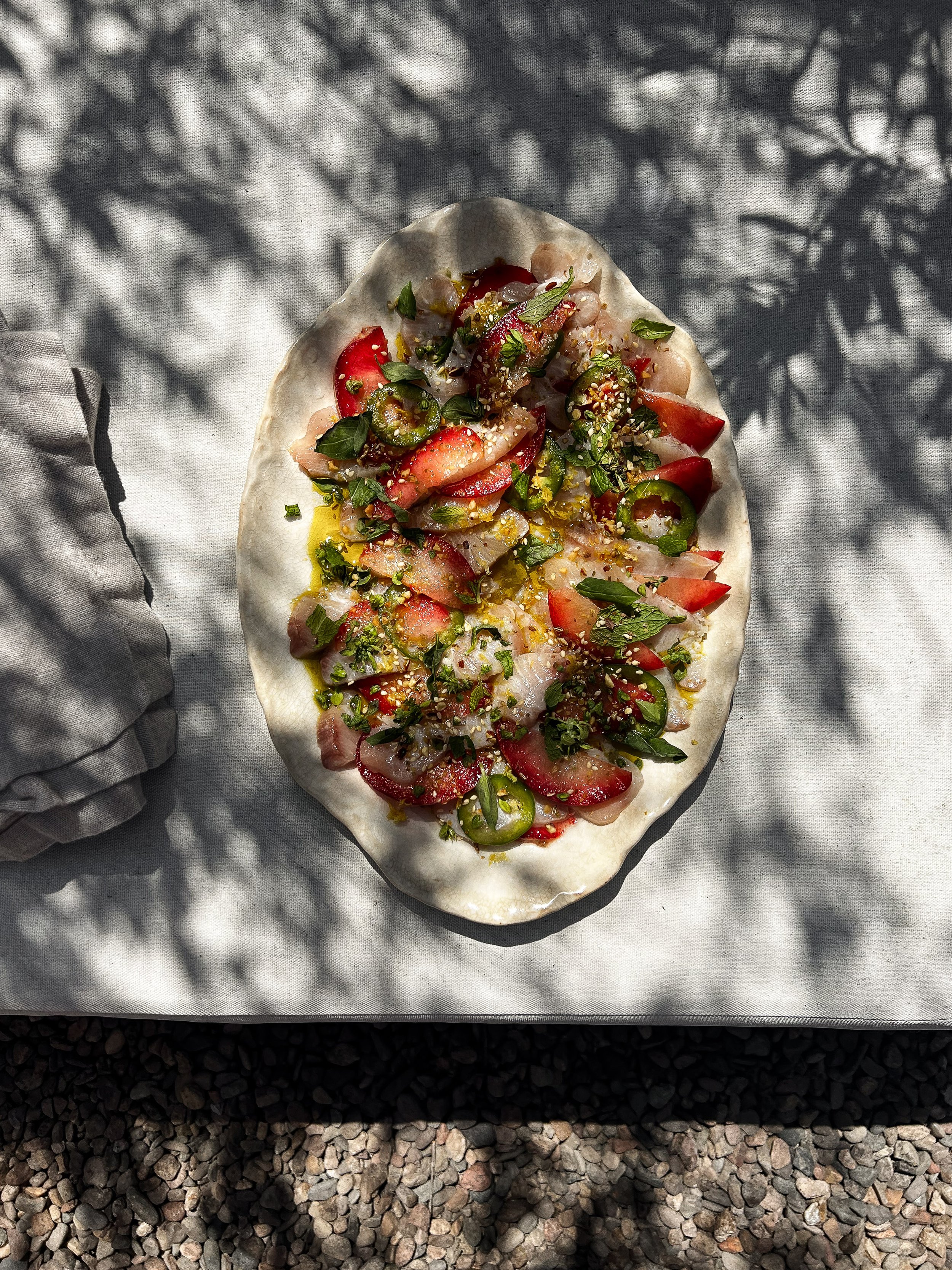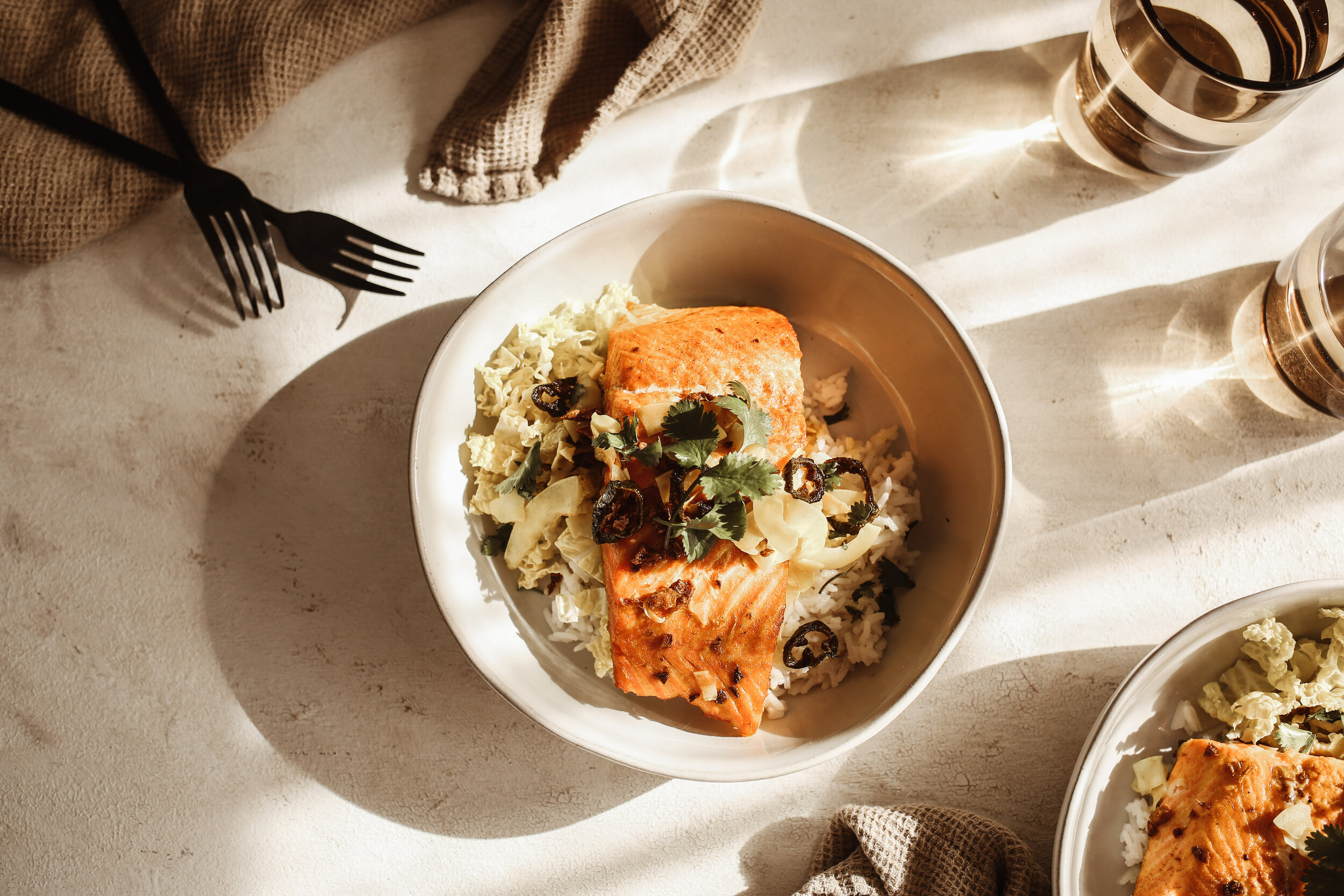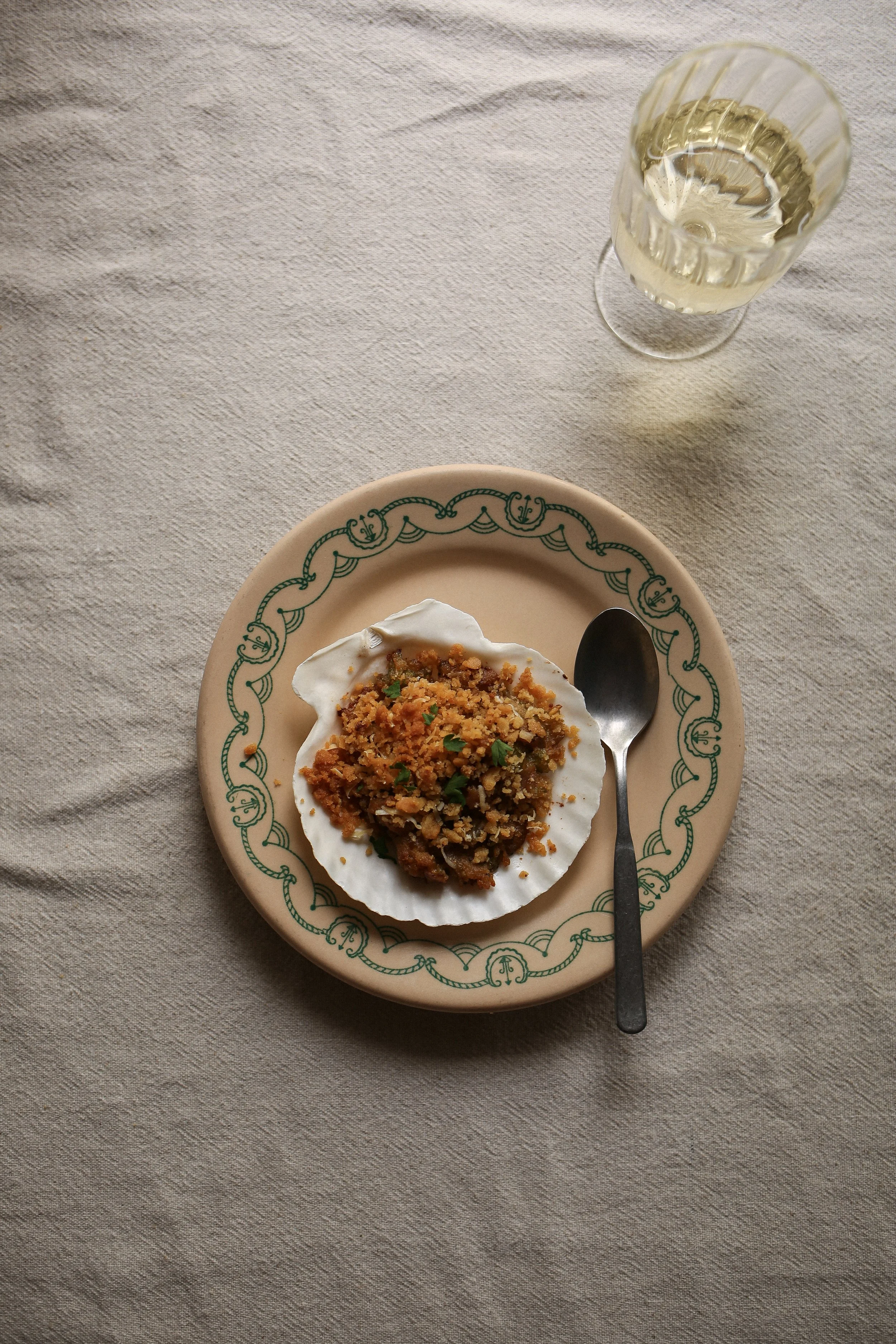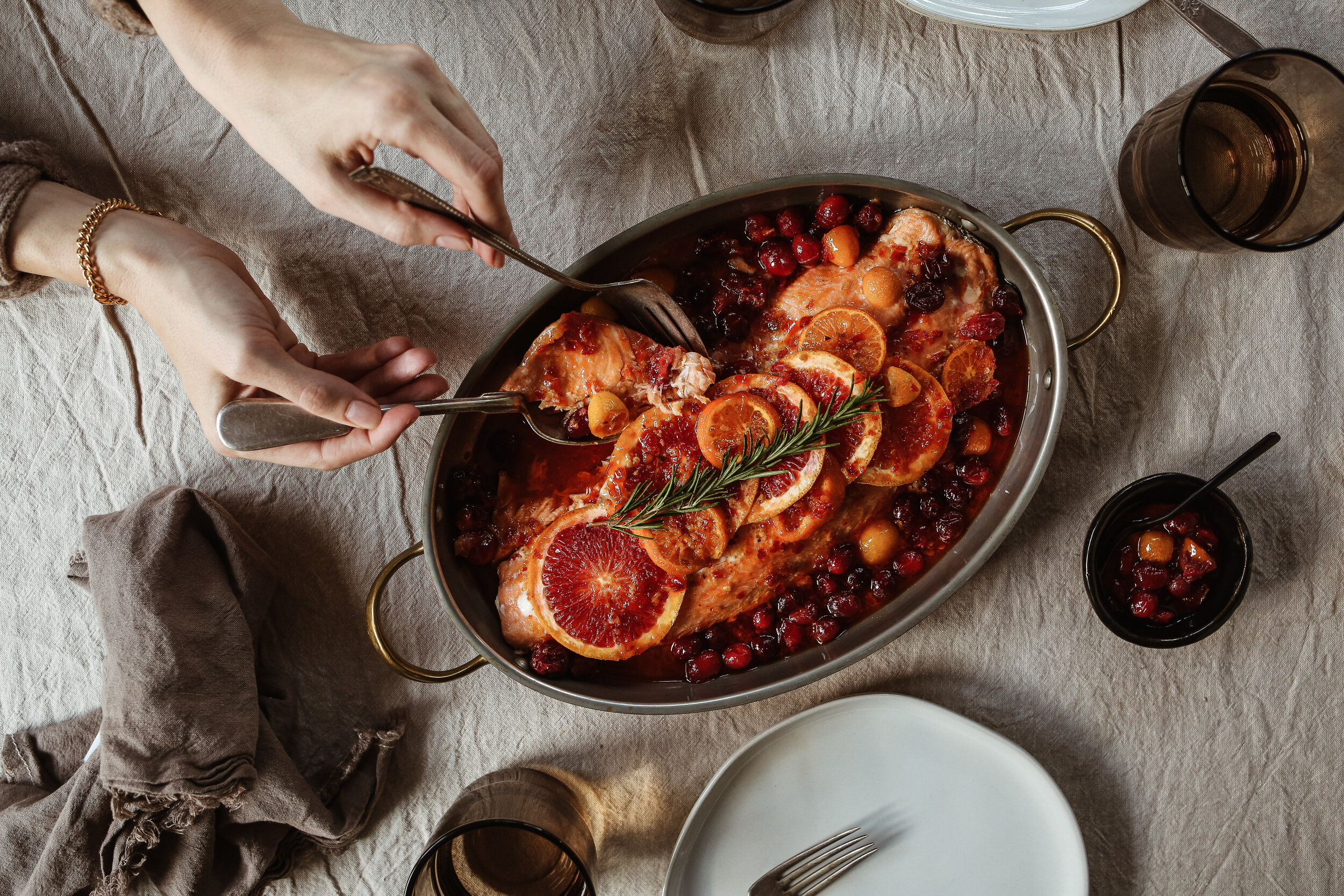Hamachi Crudo with Plums

Hamachi Crudo with Plums + Fresh Herbs
Crudo is dressed to impress but don’t let the fancy looks fool you! And don’t let the raw fish intimidate you, either! It could not be easier to make (like you literally don’t even have to know how to cook) and it only requires a few minutes and a few simple, but high quality, ingredients to make it.
Because when you’re looking for a summer dish that’s as beautiful as it is delicious, but you also don’t want to spend time in the kitchen, and you’d like to skip turning on the stove, I’m telling you, fish crudo is where it’s at. And specifically, in the case of today’s post, hamachi crudo. Paired with plums (or the stonefruit of your choice) during peak stone fruit season, fresh herbs and a hit of acidity and I’m convinced there is just about nothing better on a hot summer day. It’s a dish that is light, buttery, crisp, refreshing, packed with flavor and ready to impress. Serve it as an appetizer, enjoy it with friends or for date night at home, and, on an especially hot day, don’t be ashamed to make a plate of fresh crudo as your main dish (may or may not be speaking from experience on this one).
Hamachi Crudo with PlumS RECIPE
THE ONE THING YOU NEED TO KNOW ABOUT THIS RECIPE
I’m going to let you in on a little secret. This isn’t exactly a formal recipe. I know, I know. Then why write a whole recipe post, you ask? Touché, touché. While this may not be a formal recipe, I am still giving you an ingredient list and measurements. However, they’re pretty fluid so think of them as more of a guideline and recommendations for pairing suggestions rather than an exact formula you have to follow. The flavors can all easily be adjusted and adapted to what you have on hand, your taste preferences and even dietary needs. If you like more vinegar, add more. Better yet, use vinegar AND lime juice. Use lemon AND lime zest. If you don’t want any heat, skip the jalapeño. Add more dukkah, or don’t. Try cilantro instead of mint. Add a splash of yuzu. Don’t be afraid to run a little wild and make this crudo recipe your own. After all, this dish is much more about assembly and aesthetics than actual cooking because presentation is everything when it comes to crudo.
SO WHAT IS HAMACHI, YOU ASK?
Hamachi is Japanese amberjack, or what you might know as yellowtail. It’s similar to tuna but a little bit more decadent in flavor and firmer in texture. It’s well loved for it’s distinct fat marbling and it’s rich, buttery flavor that’s slightly sweet yet delicate. It doesn’t taste fishy at all, rather it’s quite clean and mild, but its fattiness makes it perfect for pairing with sweet fruit, fresh herbs and/or citrus (the acidity helps to cut the richness).
Hamachi is especially popular in Japan and Japanese cuisine where you’ll often see it served raw as sushi, sashimi or crudo.
OK, BUT TELL ME MORE. WHAT EXACTLY IS CRUDO?
Crudo quite literally translates to “raw” in Italian.
Now you might be thinking there are a lot of different raw meat and seafood dishes, and you wouldn’t be wrong. So what exactly is the difference between all of them and what makes crudo, well, crudo? Well the differentiating factor really comes down to preparation and presentation. In other words, the difference between crudo, ceviche, poke, sashimi, tartare, carpaccio, etc. are in things such as the type of protein being used (beef, fish, etc.), how it’s sliced (cubes vs thinly sliced, for example) and how it’s dressed (soy sauce, lemon juice, ponzu, basically the acid that will lightly “cook” the raw protein).
Sashimi, for example, means the fish is finished with soy sauce. Ceviche, while dressed similarly to crudo, is cut into cubes versus slices before being tossed in its dressing. Crudo, however, means the fish is thinly sliced, usually into some sort of rectangular shape, and the dish is finished with oil (typically olive oil), citrus and some sort of vinaigrette or acid, which is drizzled over the fish versus the fish being tossed with the dressing.
HAMACHI CRUDO Ingredients
This recipe is all minimal but quality ingredients, so while it doesn’t require much, for the best results I recommend making sure everything is the freshest, highest quality you can get (especially with the fish!).
SUSHI-GRADE HAMACHI- skin removed and major emphasis on the ‘sushi grade’, which is an absolute must!
PLUMS- I especially love to use plums for this crudo dish, but any variety of stone fruit will do, the juicer the better, preferably farm fresh ones for the best flavor
JALAPEÑO- you could also use serrano chili peppers for more heat
AVOCADO OIL- I love using Westbourne’s finishing oil. Sesame oil also tastes delicious in this recipe!
RICE WINE VINEGAR- but lemon and/or lime juice can also be used
LEMON ZEST- lime zest also works nicely
FRESH MINT AND BASIL- if possible I like to use either herbs I’ve grown or gotten at the farmers market for the freshest flavor; cilantro also tastes great in this crudo! And don’t forget to use the basil flowers, too! They look so pretty and add so much flavor and texture!
DUKKAH- you can use sesame seeds instead
TOOLS YOU NEED TO MAKE THIS HAMACHI CRUDO RECIPE
FISH KNIFE- the best for precisely slicing thin pieces of fish, however a really sharp chefs or pairing knife will work, too
SHARP CHEFS OR PAIRING KNIFE or a MANDOLIN- for slicing the plums and pepper
CUTTING BOARD- I like to use this upcycled plastic board for cutting the fish and a wood cutting board for everything else
HOW TO MAKE PLUM + HAMACHI CRUDO
As I mentioned above, crudo might just be the easiest thing to make. Simple ingredients, minimal effort, and no cooking! Really just think of it as a game of assembly and aesthetics because presentation is everything with this dish. Here’s the step-by-step how to-
STEP 1- SLICE THE FISH
Slice the fish against the grain into super thin rectangular shaped slices. We’re looking for super thin slices here. This is easier to achieve when the fish is cold so be sure to slice it straight from the fridge, or pop it into the freezer for a few minutes before slicing. You should also be able to ask your fish monger to do this for you when you ask them to remove the skin (which is what I will do if I know I’m going to be making my crudo as soon as I get home as it helps me save time and clean up in the kitchen).
STEP 2- PREP THE PRODUCE
Keep the plum and jalapeño slices paper thin so that they pair perfectly with the delicate texture of the fish and don’t totally overpower the flavors. You can, of course, use a knife for this, but a mandolin is also great for getting even thinner, more even slices.
STEP 3- ASSEMBLE THE CRUDO + SERVE
Artfully layer and arrange the fish, fruit and jalapeño slices on a serving dish. Drizzle with oil and vinegar, then finish with lemon zest grated over the top, a hefty handful of rough chopped herbs and a generous sprinkle of dukkah. Serve immediately and enjoy!
NOTES, TIPS, SUBSTITUTIONS + FAQ
DO YOU HAVE TO USE HAMACHI?
Because of it’s rich but mild flavor, hamachi works best for this dish. However, you can also use ahi tuna or yellowfin tuna, or another mild fish. Just be sure that no matter what kind of fish you use that it’s sushi grade!
WHERE CAN I FIND SUSHI-GRADE FISH?
You can find sushi grade fish at your local seafood market or a Japanese or Asian grocery store. Occasionally Whole Foods will also have a sushi grade fish at their seafood counter, but it’s not a guarantee. Many grocery stores will also sell sushi-grade fish frozen so it will just need to be defrosted before using it. If you’re on the West Side of Los Angeles, I like to get my sushi-grade fish from Santa Monica Seafood Market.
CAN THIS BE MADE AHEAD OF TIME?
No, this dish is definitely one of those that needs to be enjoyed as soon as it’s assembled (Good thing it’s so easy to throw together, right?!). Because it’s made up of simple, fresh ingredients, you want those to be as vibrant as possible when you serve them for maximum flavor and texture. The minute the vinegar and sauces hit the fish the acidity starts “cooking” it, your herbs will start wilting, the produce will get soft and the dukkah will lose its crunch and nobody wants crudo like that.
SUBSTITUTIONS
Plums- If you don’t have plums, try another kind of stone fruit such as nectarines or peaches.
Jalapeño- You can use serrano pepper in place of the jalapeño, however, since it is a bit spicier I’d recommend using less of it, unless of course you like some heat, then be as generous as you want. Another way to add some heat to the dish would be with a few dashes of a yuzu hot sauce instead of the jalapeño.
Avocado Oil- Olive oil or sesame oil also work well for this dish.
Rice Wine Vinegar- Try white wine or champagne vinegar or yuzu, lemon or lime juice instead. Mirin or ponzu sauce also add lovely flavor to this dish.
Lemon Zest- Lime or orange zest also work well for this dish, or you could go really crazy and use yuzu zest if you’re lucky enough to find the citrus fruit fresh.
Mint and Basil- Feel free to use cilantro in place of or in addition to the mint and basil. I also love using flowering cilantro for this dish if it’s available.
Dukkah- Feel free to use sesame seeds, finely chopped nuts (peanuts, pistachios or macadamia nuts work well here) or omit the dukkah altogether.
WAYS TO RIFF
I love adding a few dashes of ponzu and/or yuzu juice or yuzu hot sauce if I have it. I also love adding thin slices of avocado and, if you want to bulk this dish up a bit more, you can add thin slices of cucumber, too.
HELPFUL TIPS
For the fish- Get the fish fresh and day of making the dish for the best flavor. Ask your fish monger to remove the skin and thinly slice the fish for you to cut back on prep time and clean up. However, if you are slicing your own fish, pop into the freezer for a few minutes prior to slicing as it will making the slicing easier and smoother.
For the sauce- Typically for a crudo you whisk all of the sauce ingredients together in a bowl, then pour it over the fish. However, you can also freehand it and drizzle each sauce ingredient individually over the fish assembled in a serving dish. I do both, but it really just comes down to a matter of preference, time and clean up. And in the instance of this particular crudo, because the sauce has just two ingredients, I say skip the extra bowl, whisk and spoon and just go straight for the plate.
For chopping- Make sure your knife is super sharp and for the produce I highly recommend using a mandolin if possible. It allows you to get thinner, more precise slices that, in my opinion, also look better in the overall presentation of the dish.
For serving- Since this dish is really all about its looks, keep that in mind when you select a serving dish and as you slice and arrange the different ingredients on the plate. I like to think of it almost like creating edible art (except it’s far easier than painting a picture).
WHAT TO SERVE WITH CRUDO
The lovely thing about crudo is just how wonderful it is all on its own so you really don’t need to serve it with anything. Other than a crisp cool glass of white wine or a nice rosé (like the low intervention one featured in the photos that’s from one of my favorite California wineries).
But if you do want more, I love some good sourdough, grilled or toasted, ready to sop up all the delicious juices remaining on the plate. I might also do some nice olives or crackers on the side, or quick pickled cucumbers, or if I’m turning the crudo into more of a main dish I’d also add a simple green salad, something summery like this (Hello more stone fruit!) or something a bit heartier (but still light and fresh) like this.
SHOP THE POST
EXACT (OR SIMILAR) ITEMS I USED TO MAKE THIS RECIPE + FEATURED IN THIS POST



















